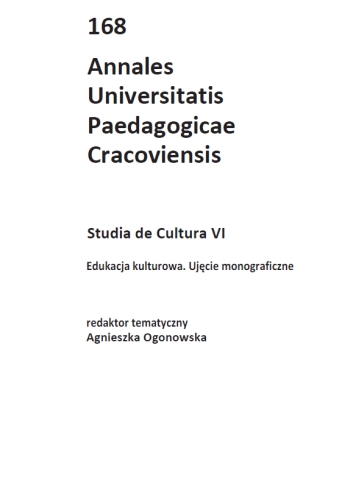Abstrakt
Intermedial social campaign: an outraged mafioso
Contemporary texts are received in intermedial contexts. Their interpretation depends on the environment, to which they belong. It also determines interpretative paradigms of texts. The film Mafia for Dogs was created as a social advertising, but represents a commercial paradigm in order to run the appropriate for him behavior and practices of receiving and of communication. A hired celebrity, Piotr Cyrwus, is known from a television series. The advertisement drew attention to a social problem, which is inappropriate and cruel treatment of dogs. A mafioso-boss is outraged and speaks directly to the viewer. The advertisement has been styled on the model of Quentin Tarantino’s Reservoir Dogs (USA 1992) and other gangster movies: The Little Caesar by Mervyn LeRoy’a (USA 1931), The Godfather by Francis Ford Coppola (USA 1972), The Roaring Twenties by Raoul Walsh (USA 1939). The soundtrack, including a song Little Green Bag performed by George Baker Selection, is known from the Reservoir Dogs. The plot takes place in an abandoned warehouse and gangsters have kidnapped policeman - just like in this movie. The cruelty of gangsters is expressed by the tools of torture, harsh light and strengthened sounds.
Employment of Piotr Cyrwus is a part of the TV convention of reporting of current events. Before the upcoming winter, homeless dogs are actually in deadly threat. In this advertisement their suffering is punishable by gangsters.
Straight lines connote the categories of rationality, but warm browns are associated with dog hair.
The advertisement was disseminated in a viral campaign. A rich intertextual and intermedial references make the reception of the advert close to contemporary receiving regimes of film, television and commercial advertising. It is located in the contemporary intermediality of cultural transfers. No reference was made, however, to literature. The campaign resulted in benefits. It has been seen by over 3.5 million people. They collected money to buy houses for dogs from shelters, for sterilization of animals and taking care of them.
Bibliografia
Aaron Y. (1931), Cropped screenshot from the trailer for the 1931 film „Little Caesar”, „Wikimedia Commons” http://commons.wikimedia.org/wiki/File:Caesar2.JPG (dostęp: 22.07.2014).
Zobacz w Google Scholar
Bauer Z. (2010), „Twój głos w Twoim domu”: cztery typy tabloidyzacji, „Oblicza Komunikacji”, nr 3, s. 37-47, http://okom.wuwr.pl/category/3-2010-tabloidyzacja-jezyka-i-kultury-58 (dostęp: 13.12.2014).
Zobacz w Google Scholar
Cinemax154 (2011), Reservoir Dogs – Wściekłe Psy – 1992 – trailer music, http://www.youtube.com/watch?v=z-anabQVu4 (dostęp: 23.09.2013).
Zobacz w Google Scholar
Dąbek A.2012), Szok! Rysiek z „Klanu” mówi kur...!, 10 XII 2012, http://film.onet.pl/szok-rysiek-z-klanu-mowi-kur/4prxn (dostęp: 15.12.2013).
Zobacz w Google Scholar
Emiliev (2013), Historia polskiej mafii, 1 VI 2013 r., http://www.sadistic.pl/historia-polskiej-mafii-vt202635.htm (dostęp: 13.12.2013).
Zobacz w Google Scholar
Mafia dla psa (2012), https://www.facebook.com/mafiadlapsa (dostęp: 12.12.2013).
Zobacz w Google Scholar
Feuer J. (1997), Telewizja na żywo: ontologia jako ideologia, [w:] Pejzaże audiowizualne. Telewizja. Wideo. Komputer, wybór, wstęp i opracowanie Andrzej Gwóźdź, Kraków, s. 128.
Zobacz w Google Scholar
Fish S. (1996), Literatura w czytelniku. Stylistyka afektywna (1970), [w:] Współczesna teoria badań literackich za granicą, t. 4, cz. I, red. H. Markiewicz, Kraków, s. 148–200. Fundacja na Rzecz Zwierząt „Przytul Psa”, https://www.facebook.com/Przytul.Psa/posts/124323194402068 (dostęp: 20.11.2013).
Zobacz w Google Scholar
Godzic W. (2004), Telewizja i jej gatunki. Po „Wielkim Bracie”, Universitas, Kraków.
Zobacz w Google Scholar
Helman A. (1990), Film gangsterski, Warszawa.
Zobacz w Google Scholar
„Internet Movie Database”, The Roaring Twenties (1939), http://www.imdb.com/media/rm4113668352/tt0031867?ref_=ttmd_md_nxt (dostęp: 12.12.2013).
Zobacz w Google Scholar
Kalaga W. (1997), Tekst – wirtualność – interpretacja: w sprawie przybijania gwoździ, „Teksty Drugie” 1997, nr 6, s. 83–92.
Zobacz w Google Scholar
Kampaniespołeczne.pl, http://www.kampaniespoleczne.pl/index.php (dostęp: 10.12.2013).
Zobacz w Google Scholar
Kaspar Capparoni Rex, http://pl.wikipedia.org/wiki/Plik:Kaspar_Capparoni_Rex.jpg (dostęp: 12.12.2013).
Zobacz w Google Scholar
Rysio z klanu twierdzi, że kampanie społeczne to g**no, http://www.kampaniespoleczne.pl/
Zobacz w Google Scholar
kampanie,2575,rysio_z_klanu_twierdzi_ze_kampanie_spoleczne_to_g_no (dostęp: 10.12.2014).
Zobacz w Google Scholar
Markiewicz H. (1997), Staroświeckie glosy, „Teksty Drugie” 1997, nr 6, s. 46–49.
Zobacz w Google Scholar
Mediafun (2012), Rysiek z Klanu wraca do gry, 10 XII 2012 r., http://www.youtube.com/watch?v=1quiKLMy0ng (dostęp: 19.11.2013).
Zobacz w Google Scholar
Mediafun (2013), Mafia dla psa – making of i niewykorzystane sceny, 8 I 2013 r., http://www.youtube.com/watch?v=BjUa3-AzLuk (dostęp: 19.11.2013).
Zobacz w Google Scholar
Ogonowska A. (2009), Telewizja w edukacji medialnej, Universitas, Kraków.
Zobacz w Google Scholar
Propaganda dobrych serc czyli Rzecz o reklamie społecznej (2002), red. Dominika Maison, Piotr Wasilewski, Agencja Wasilewski, Fundacja Komunikacji Społecznej, Kraków.
Zobacz w Google Scholar
Rorty R. (1996), Kariera pragmatysty, [w:] U. Eco, R. Rorty, J. Culler, Ch. Brookes-Rose, Interpretacja i nadinterpretacja, Kraków, s. 88–106.
Zobacz w Google Scholar
Salander (2013), „Nie dostaję propozycji reklamowych!”, http://www.pudelek.tv/video/Nie-dostaje-propozycji-reklamowych-1955/ (dostęp: 10.12.2013).
Zobacz w Google Scholar
Skolimowski H. (1991), Problemy racjonalności w biologii, „Literatura na świecie” nr 3
Zobacz w Google Scholar
Stępniak K. (1993), Słownik tajemnych gwar przestępczych, Puls, Londyn 1993, s. 398.
Zobacz w Google Scholar
Szahaj A. (1997) Granice anarchizmu interpretacyjnego, „Teksty Drugie” nr 6, s. 5–33.
Zobacz w Google Scholar
The Roaring Twenties (1939), http://www.imdb.com/media/rm4113668352/tt0031867?ref_=ttmd_md_nxt (dostęp: 12.12.2013).
Zobacz w Google Scholar
TW (2012) Rysiek z „Klanu” w mafijnej kampanii Fundacji Przytul Psa (wideo) (dostęp: 11..12.2012), http://www.wirtualnemedia.pl/artykul/rysiek-z-klanu-w-mafijnej-kampanii-fundacji-przytul-psa-wideo# (dostęp: 22.09.2013).
Zobacz w Google Scholar
TW (2013), Efekty „Mafii dla Psa”: 100 tys. zł od internautów, 1.6 tys. euro z reklam (wideo case study), wpis z 3 III 2013 r., http://www.wirtualnemedia.pl/artykul/efekty-mafii-dla-psa-100-tys-zl-od-internautow-1-6-tys-euro-z-reklam-wideo-case-study (dostęp: 23.09.2013).
Zobacz w Google Scholar

